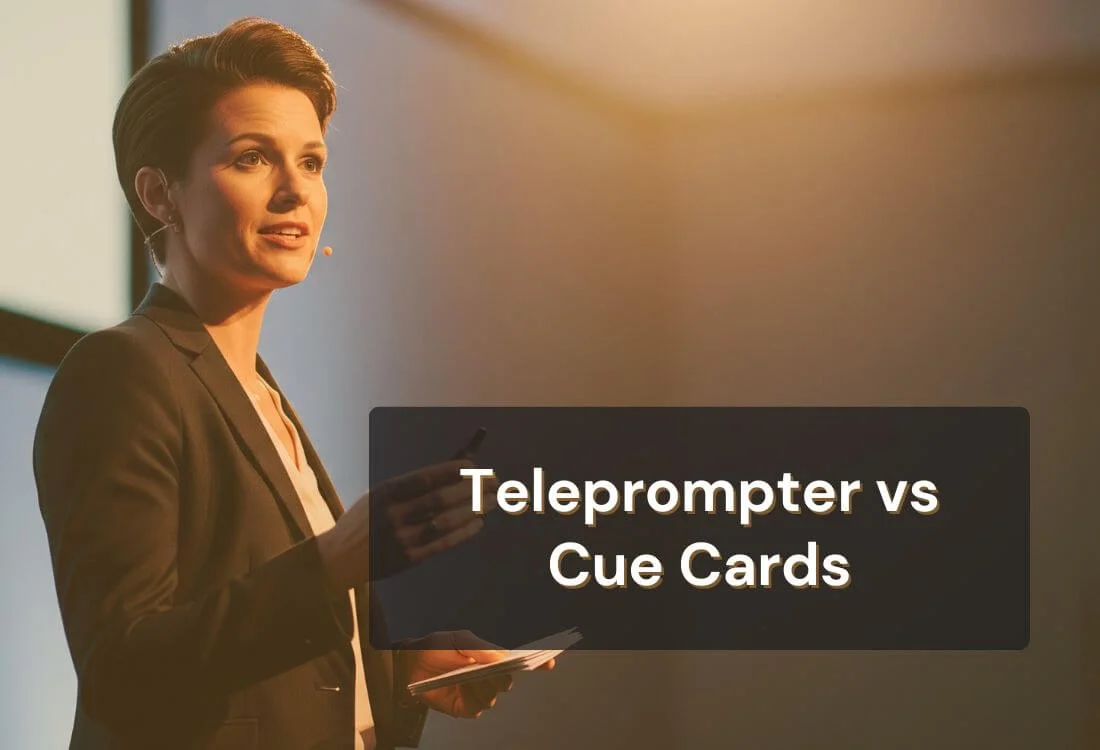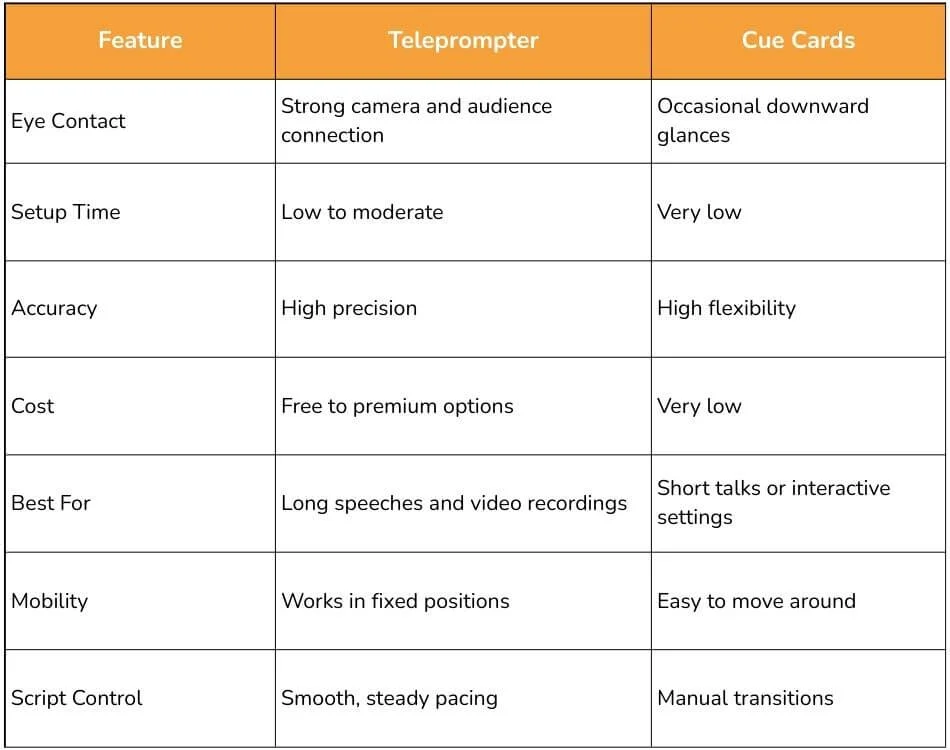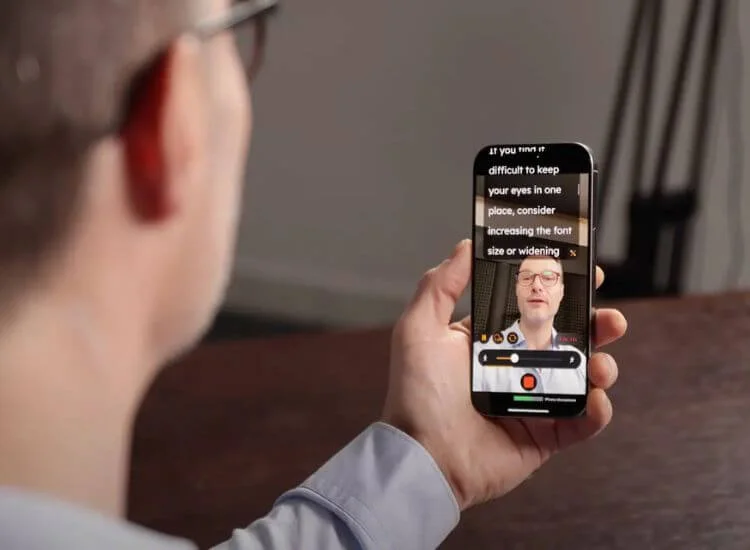



Presenting your ideas clearly often depends on how well you support yourself during the speech. Some speakers feel more confident with a teleprompter guiding each line, while others prefer the familiar feel of cue cards in hand.
If you have ever compared teleprompter vs cue cards, you already know the choice can influence your pacing, focus, and connection with the audience. Both tools bring their own strengths, and understanding how they shape your delivery makes it easier to choose the one that helps you speak with confidence.
This guide explains how each tool works, who benefits from them, and how they shape your delivery. It also shows when a speech teleprompter, cue cards, or a teleprompter app can help you present with more confidence and connection.

A teleprompter is a device or software that displays scrolling text in front of the speaker. Many people recognize the clear glass panels used on stages and during televised speeches. These panels reflect the script toward the speaker without exposing it to the audience. This allows the presenter to maintain strong eye contact while following the script.
Modern presenters often use mobile teleprompter apps on phones and tablets. These apps mimic the experience of larger teleprompters, allowing speakers to adjust speed, layout, spacing, and font size. Teleprompters support consistent pacing and make it easier to keep your message organized during long or complex presentations.
Because the text sits in your line of sight, you can focus on your audience, the camera, or the room without shifting your attention. This creates a natural connection that helps your delivery sound polished and controlled.
Teleprompters support many speaking styles. These key advantages matter most to presenters who want to sound polished and prepared.
Want to go deeper? See more ways a teleprompter can support your delivery in this guide: The Benefits of Teleprompters.

Cue cards are physical cards or sheets that hold key points or reminders for your talk. They are simple, quick to create, and easy to use. You write only the most important ideas or transitions on each card, which helps you speak in your own words.
Speakers who enjoy a conversational tone often prefer cue cards. The cards let you glance at your prompts without reading full sentences. They work well for meetings, workshops, short speeches, and spontaneous segments.
You can hold them in your hand or place them in a cue card holder. Some presenters use large-format cards to improve visibility from a distance. Their simplicity and low cost make cue cards a popular choice for many speaking environments.
Presentation cue cards offer practical advantages for speakers who value simplicity and flexibility.
A few simple tools help maximize the effectiveness of cue cards.
Choosing between teleprompter vs cue cards becomes easier when you see how each tool supports real presentation needs. This comparison outlines important factors that influence clarity, delivery, and comfort. Both tools can help you speak with confidence, and understanding their strengths helps you pick the setup that fits your speech style.
Below is a simple overview of how each method supports different speaking needs:

This comparison highlights the strength of each tool and helps you decide which one supports your presentation style.
Teleprompters help speakers who want structure, accuracy, and steady pacing. They work well for:
Long presentations often include detailed explanations, transitions, and data. A teleprompter helps you move through your script without losing momentum or skipping key information. It supports training videos, leadership messages, investor updates, and formal talks where accuracy matters.
Video recording requires steady eye contact with the camera. A teleprompter places the text near the lens so your attention stays centered. This creates a natural sense of connection that feels more personal. It works well for YouTube videos, online courses, marketing content, and livestreams.
Some presenters prefer to follow a script to stay aligned with brand tone or compliance standards. A teleprompter supports this approach by guiding you from the opening line to the final message. This reduces the pressure of memorizing long passages and helps you speak with confidence.
Teleprompters allow for adjustable text sizes and spacing, making scripts easier to read at different distances. Presenters can also color-code lines to highlight transitions, pauses, or emphasis. Features like these support smooth delivery and reduce eye strain.
Teleprompters appear often at press briefings, virtual keynotes, broadcast studios, and corporate events. These setups help speakers maintain strong presence and clarity. The stable script display creates a calm environment for presenters who want full control over their message.

Cue cards help you maintain a relaxed tone and flexible pacing. They work well for:
Short presentations give you freedom to speak in your own words. Cue cards guide your structure while still encouraging a natural tone. This helps during announcements, classroom lessons, team briefings, or updates where you move from point to point easily.
Workshops and small group settings often involve two-way communication. Cue cards help you stay organized while still responding to the room. They let you step away from the podium or move through the space while keeping your key ideas visible in your hand.
Some presenters enjoy a relaxed speaking style. Cue cards allow you to change your phrasing or expand on points based on the audience’s reactions. They keep your talk structured but not rigid.
Cue cards take only a few minutes to create. You can write phrases, color-code sections, and number the cards to track your flow. This system works well for speakers who want full control over their notes without relying on technology.
Smaller settings often benefit from personal interaction. Cue cards let you break eye contact only briefly before returning your attention to the audience. These subtle pauses feel natural and do not disrupt your message.
Both tools can support a strong performance, and these practical factors will help you decide which setup fits your needs.
Your budget often plays a role in your decision.
Some speakers enjoy using technology. Others prefer tools they can hold and control themselves.
The size of your venue influences how your tools support you.

A teleprompter works best when your script is clear and you rehearse the flow. These simple habits help you speak smoothly, maintain eye contact, and stay on pace.
Want more techniques? Check out these tips for reading a teleprompter.
Cue cards help you keep a natural tone while staying organized. A simple, clear system prevents distractions and supports a smooth presentation.
Many presenters combine teleprompters and cue cards for greater flexibility.
Teleprompters support the core structure of your talk. They help you stay aligned with your main script during key moments such as introductions, important explanations, and closing statements. When your script displays clearly in front of you, you maintain strong eye contact and steady pacing.
Cue cards serve as a safety net during your presentation. They can hold small prompts such as names, statistics, examples, transitions, or audience interaction cues. Some speakers place cue cards on a nearby stand so they can glance at them without disrupting their flow.
Practice shifting between the teleprompter and your cue cards during rehearsals. When you finish a scripted segment, you can briefly look at your cards to confirm the next topic. This keeps your delivery calm and controlled. Blending tools works well for conferences, workshops, training sessions, and speeches with multiple sections.

Teleprompter apps serve as a strong cue card alternative by turning your phone or tablet into a controlled script display. They support:
They include adjustable speed, formatting, and color cues. These features support both new speakers and experienced presenters who want portable tools.
Teleprompter.com offers simple controls, fast script import, and clear layouts, making it easy to stay focused and organized from any location.
Experience how simple presenting can be with Teleprompter.com. Sign up to use a portable teleprompter app that keeps your script clear and your delivery steady.
Choosing between teleprompter vs cue cards comes down to your environment and speaking style. Teleprompters support structure and accuracy, especially during video recordings and long speeches. Cue cards help you speak naturally and adjust to the room during shorter or more interactive sessions.
Some speakers blend both tools, using a teleprompter for main ideas and cue cards for reminders. Teleprompter apps add even more flexibility because they work anywhere and fit a wide range of presentation needs.
With the right tool, you can deliver your message with clarity, confidence, and steady control. Your presentation becomes easier to manage, and your audience engagement becomes stronger.
Cue cards can be better for speakers who prefer a natural and conversational tone because they highlight only key points. A full script offers more control but can limit flexibility, while cue cards let you adapt your phrasing as you speak.
The main purpose of a teleprompter is to display a script in the speaker’s line of sight so they can maintain eye contact. This helps improve pacing, confidence, and clarity during speeches, video recordings, and presentations.
Cue cards can interrupt eye contact and create small pauses when you look down to read them. They can also become distracting if the cards shuffle, contain too much text, or are not organized clearly.
You do not need to memorize your speech when using a teleprompter because the full script appears in front of you. A basic rehearsal helps you match your pacing to the scroll, but the device handles the text.
You can sometimes tell someone is using a teleprompter if their eyes stay fixed on a single point, following teleprompter cues without much shifting. Modern setups and proper alignment reduce this effect, making the teleprompter nearly impossible to detect.
Yes, a teleprompter app can replace a physical teleprompter for most presentations and video recordings. Apps provide adjustable speed, clear text, and easy script import, making them a practical option for speakers who want portability and simple setup.



